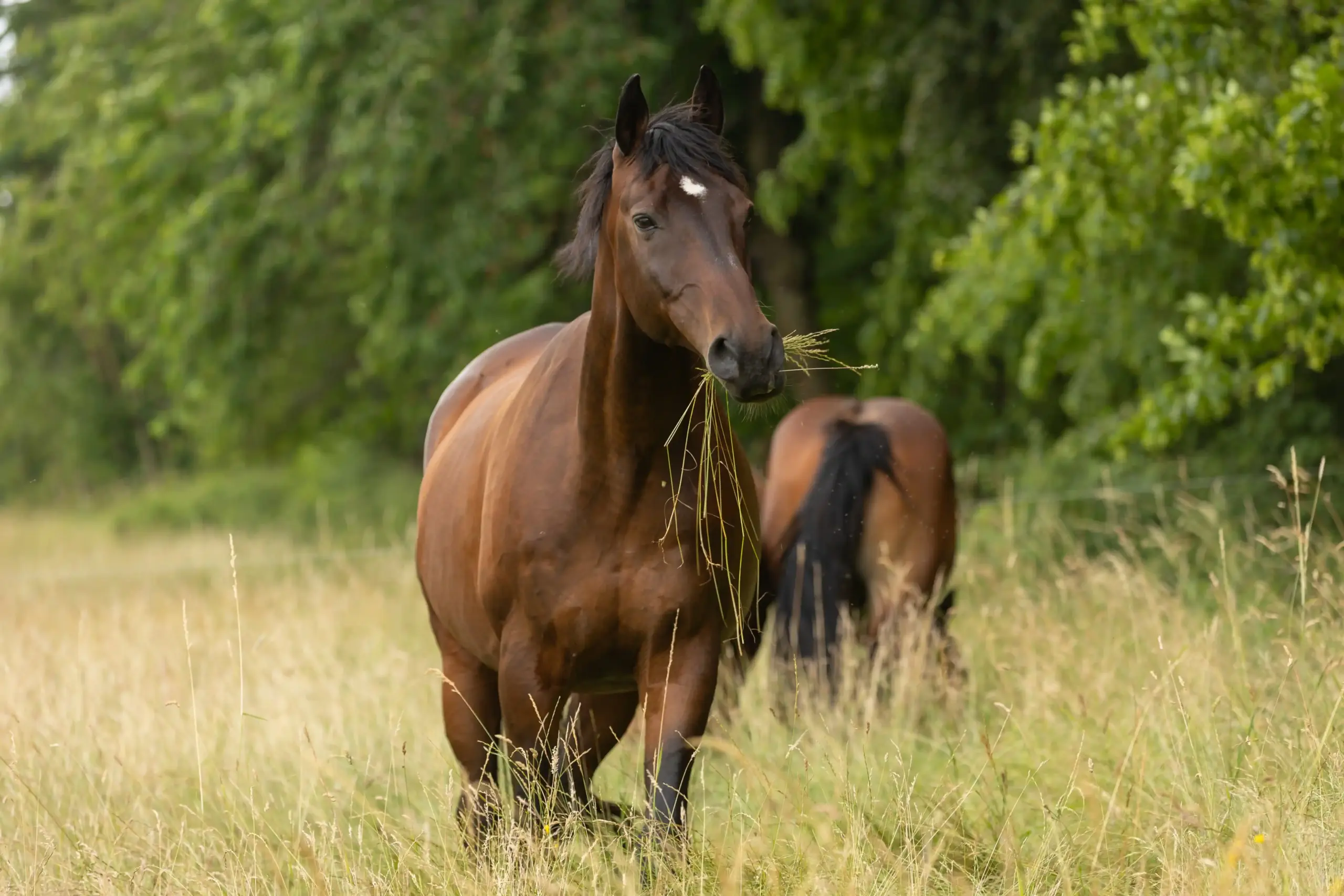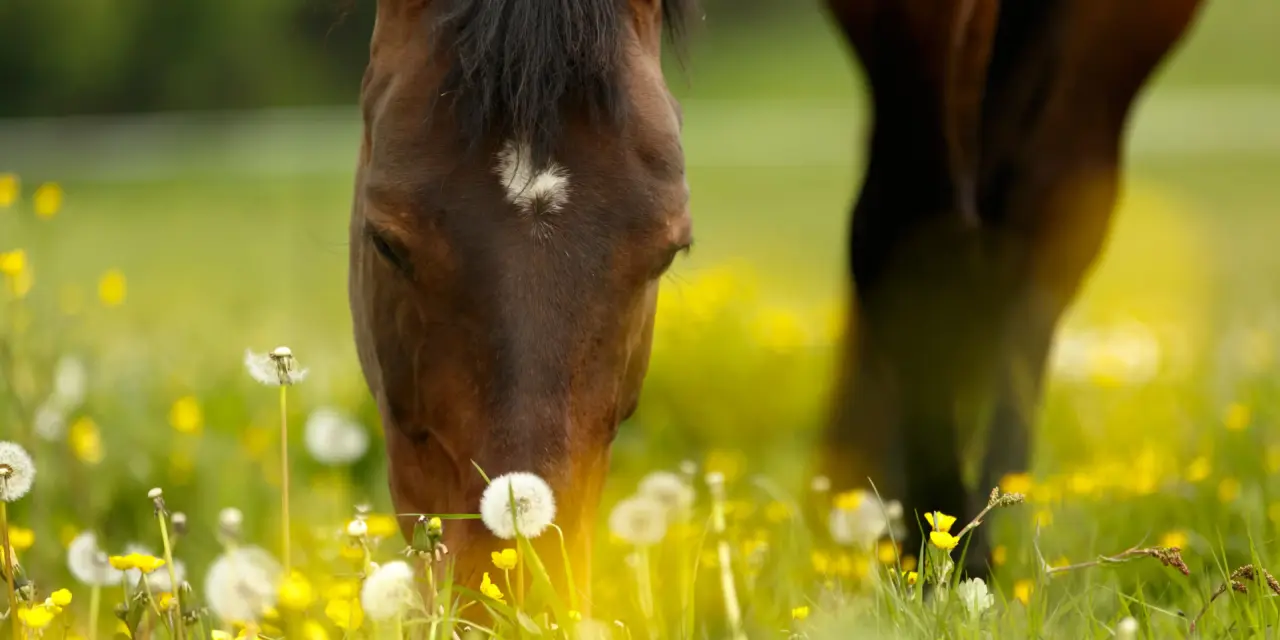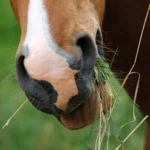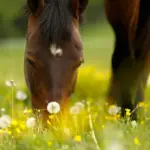The 5 key points at a glance:
- Cold nights followed by sunny days = maximum sugar levels, especially when soil temperatures drop below 5 °C.
- Warm, cloudy or rainy days → lower sugar levels due to reduced photosynthesis.
- Early mornings see low sugar levels, as plants use up sugars overnight.
- In the afternoon, on sunny days, sugar levels peak because lots of sugar has been produced but not yet used.
- Thunderstorm weather with high humidity and overcast skies generally leads to lower sugar levels, although plant roots can still act as sugar reserves.
Why is the sugar content in grass important?
The term “sugar content” actually covers several types of sugars. It includes simple and double sugars (like glucose, fructose and sucrose), as well as storage sugars such as starch and fructans. Altogether, these are grouped under what’s known as “non-structural carbohydrates” (NSC). These sugars are essential for all horses, but they become especially critical for horses with metabolic issues like laminitis, insulin resistance, PSSM or Equine Metabolic Syndrome (EMS). Particularly high NSC levels in the grass can trigger acute health problems in sensitive horses.
What exactly is photosynthesis?
Photosynthesis is the process by which plants produce sugars — their main source of energy — from sunlight, carbon dioxide in the air, and water. The green pigment chlorophyll acts like a solar panel, capturing sunlight and using its energy to convert these simple raw materials into glucose. The more intense and prolonged the sunshine, the more active this natural “sugar factory” becomes. That’s why grasses and other plants contain significantly more sugar on warm, sunny days than on cloudy, cool days or at night, when photosynthesis comes to a halt. At night, plants use up some of their stored sugar reserves to fuel their own metabolism. Additionally, these sugars are used to build structural carbohydrates like cellulose, which the plant needs for growth and stability.
Influence of the time of day
The time of day has a significant impact on the sugar content in grass, closely linked to how active photosynthesis is and how much sugar the plant has used up overnight. In the early morning, especially before sunrise, the level of non-structural carbohydrates (NSCs) is generally at its lowest. This is because the plant draws on its stored sugars during the night to fuel cell growth and keep its metabolism running.
As the day progresses, especially on sunny days, the rate of photosynthesis increases, leading to greater sugar production. By the afternoon, grass often has its highest levels of soluble sugars and fructans, because large amounts have been produced but not yet converted into new plant tissue. This makes the late afternoon a particularly risky time for horses prone to metabolic issues.
But as with all things, there are exceptions — weather conditions also have a significant impact on the sugar content of grass.
Impact of the weather
Weather conditions also have a big impact on the sugar content of grass, through factors like light intensity, moisture, and temperature. On clear days with plenty of sunshine, photosynthesis is especially active, and plants produce large amounts of sugar. If growth is slowed down by other factors (such as cold temperatures), these sugars are often stored as fructans.
In contrast, on cloudy or rainy days, there is less light available, so photosynthesis slows down and the plants produce less sugar. Warm, damp weather also encourages plants to use the sugars they do make straight away for growth, which lowers the overall non-structural carbohydrate (NSC) content even further.
In thundery weather or during heavy, humid heat, there’s a lack of solid scientific data, but practical experience suggests that sugar levels in grass tend to be lower under these conditions. This is likely due to a mix of reduced sunlight and more active plant growth. More recent studies also indicate that when plants are under stress — for example from fluctuating temperatures and moisture — they store extra sugar in their roots. This root reserve plays an important role in helping plants stay resilient.
Height of the grass
It’s also important to mention that the height of the grass plays a crucial role. The highest concentration of sugars is typically found in the bottom 8 cm of the stem. This is why horses should not graze on pastures where the grass is too short, as this can lead to increased sugar intake.
Additionally, endophytes—fungi that live in symbiosis with grass—are usually concentrated in the lower parts of the stem. These fungi produce toxins that can put extra strain on the horse’s metabolism and potentially cause health problems.
Temperature as a key factor
Especially crucial for sugar accumulation in grass is the temperature – particularly the soil temperature. When the soil drops below about 5 °C, the growth of the plant slows dramatically. However, photosynthesis under sunlight continues to produce sugars. Because this sugar can’t be used to build new plant tissue under these conditions, it gets stored as fructans – often in very high concentrations. The levels of soluble sugars also tend to rise in such situations.
Once soil temperatures climb back above around 5 to 6 °C, plant growth picks up again. The sugars are then increasingly used for cell development, which lowers the overall sugar content in the grass. Ideally, you would want temperatures above 15 °C combined with overcast skies or rain – under these conditions, fructan formation is at its lowest because the sugar is channelled directly into growth rather than stored.
Drought, heat and extreme wet conditions
In addition to light and temperature, the water supply to plants has a significant impact on the sugar content of grass. Drought, heatwaves and prolonged wet conditions each affect sugar concentration in different ways:
Drought and heat
During prolonged dry spells combined with high temperatures, plants often respond with what’s known as “stress sugar accumulation.” When water is scarce, plant growth slows down, but under intense sunlight, photosynthesis continues. The sugars produced can’t be channelled into growth, so they’re stored as fructans — sometimes in very high concentrations. Levels of soluble sugars (like glucose and sucrose) also often rise under these conditions. On top of that, during periods of stress, more sugar is shifted into the roots to act as an energy reserve and help protect the plant from drying out.
This combination is particularly problematic:
- hot days (over 25–30 °C),
- clear, intense sunshine,
- and little to no rain for several days or even weeks.
In such situations, grass that looks rather “scorched” on the outside can still be very high in sugar — a deceptive state that poses real risks for sensitive horses. (Incidentally, the same applies to hay: that beautifully green, lush-looking hay may actually be lower in sugar than older, yellowish hay!) This is particularly common on closely grazed pastures, which are already under more stress during dry spells.
Excessive moisture and waterlogging
In contrast, during periods of persistent wet weather, overcast skies and mild temperatures, the sugar content of the grass is often considerably lower. The plants absorb plenty of water, grow vigorously and convert available sugars into new leaf tissue. At the same time, the lack of sunlight on rainy days means less sugar is produced in the first place.
Air pressure and sugar content
Air pressure doesn’t have a direct physiological effect on the sugar content of plants. However, falling air pressure — typically seen when poor weather or thunderstorms approach — is often accompanied by changes in the weather: increased humidity, more cloud cover and reduced sunlight. These conditions lower the rate of photosynthesis, which in turn leads indirectly to a lower sugar content in the grass. While air pressure alone isn’t a reliable indicator, it can, in combination with other weather signs, give a useful clue that sugar levels in the grass may be on the lower side.
Differences between grass and clover species
The sugar content — and particularly the levels of fructans — can vary quite significantly between different types of grasses and herbs:
- Ryegrass (English ryegrass or perennial ryegrass) often has especially high fructan levels, particularly in cultivars bred for high-yield dairy cows.
- Meadow fescue and Kentucky bluegrass (or meadow grass) are also typically high in sugars.
- Timothy grass (Phleum pratense) contains significantly lower fructan levels.
- Clover species (such as red and white clover) mainly store sugars as starch and generally have a lower fructan content compared to many grasses.
With herbal mixtures too, the sugar concentration tends to be more moderate. The composition of the sward therefore has a significant impact on the sugar levels in the forage. Grasses better suited for horses include meadow foxtail, red bentgrass, creeping bentgrass, crested dog’s-tail, orchard grass (also known as cocksfoot), red fescue, timothy, and annual meadow grass.

Practical importance for grazing season
For horses with insulin resistance, a tendency to laminitis, or other metabolic issues, high levels of non-structural carbohydrates (NSC) in grass can pose serious health risks. Understanding the factors that influence these sugar levels can help you avoid high-risk grazing periods and better protect your horse’s health.
Especially risky are cold spring days with clear skies, bright sunshine and frosty nights — under these conditions, grass can have extremely high sugar and fructan concentrations. On such days, horses with metabolic imbalances should ideally be kept off pasture.
Far more favourable are warm, damp days with overcast skies or light rain — ideally following a frost-free night. In these conditions, the sugar content of the grass is usually low, and the risk to sensitive horses is greatly reduced. If nighttime temperatures stay above 5–6 °C and the day is sunny, it’s better to turn horses out to graze in the morning. If it remains overcast, grazing is generally safe throughout the day. Drought stress also raises sugar levels in the grass, so it’s safer to let horses graze in the morning, ideally when a touch of morning dew still provides some moisture to the plants.
In addition to grazing, hay should always be available so that horses aren’t forced to nibble overly short grass or rely solely on very leafy, young pasture, which can disrupt healthy gut movement.
As a general rule:
- Only turn horses out to graze when the grass is at least 20 cm high.
- If horses are grazing on grass taller than 20 cm for more than four hours, always provide extra hay in the field.
- If the pasture is already well grazed down (shorter than 20 cm), offer hay even if they’re only out for less than an hour.
- Grass shorter than 10 cm isn’t really suitable for grazing at all — it should be treated as turnout for exercise only, and hay must be provided. Ideally, move horses to a field with better regrowth.
If you’re unsure about the sugar content of your pasture, there’s a simple way to test it. Take some fresh grass and either press it directly in a garlic press or roll it firmly between your hands for at least 60 seconds. Then place it in a garlic press to squeeze out a drop of juice. Put this drop onto a refractometer to check the sugar levels. This reading gives you the NFC value, which includes all simple and complex sugars as well as storage sugars like fructan. If you press the grass straight away or roll it only briefly, you’ll mostly measure the simple sugars. The longer you roll the grass beforehand, the more fructan will also be released and included in the measurement. If you’d like more detailed guidance, there’s also a step-by-step tutorial on how to measure sugar levels in hay: Sugar Test Method
- Assessing the correct body condition in horses - 21. June 2025
- Sugar levels in grass – when do they become a problem? - 19. June 2025
- Choosing the Right Fly Sheet: The Ultimate Guide for Horse Owners - 13. June 2025






